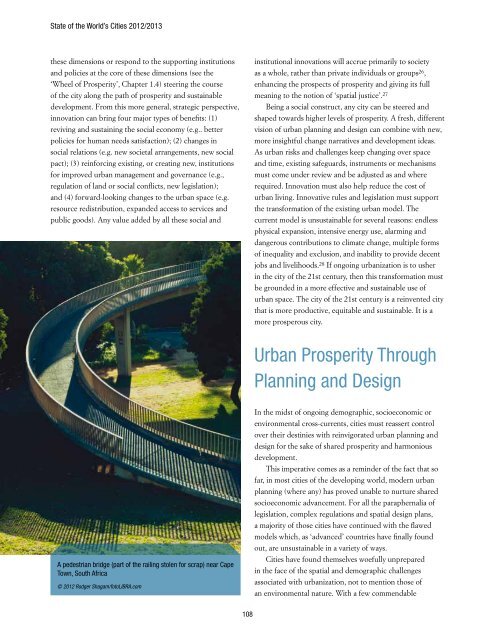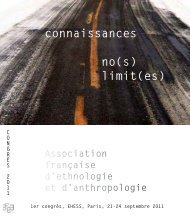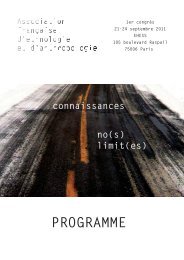Innovating to Support <strong>the</strong> Transition to <strong>the</strong> City <strong>of</strong> <strong>the</strong> 21st Centurymodel to rebuild local government and improve servicedelivery. Bangalore in India has launched technologybasedpublic-private experiments in governance in a bidbetter to deliver public services, too. In Latin Americaand <strong>the</strong> Caribbean, Rosario, just like Santo Domingo, hasintroduced significant institutional innovations in terms <strong>of</strong>participatory governance. In Nairobi, Kenya, <strong>the</strong> privatesector has launched ‘Pesapal’ a new payment platformenabling low- and middle-income residents to conducte-commerce transactions and even to pay school fees via cellphones or <strong>the</strong> Internet.Many o<strong>the</strong>r social and institutional innovations involve<strong>the</strong> creation <strong>of</strong> new systems and models to meet <strong>the</strong> needs<strong>of</strong> underserved populations in a more efficient, effective,and sustainable manner. In Iran’s Tehran, <strong>the</strong> scope <strong>of</strong> <strong>the</strong>WHO-UN-Habitat ‘Urban HEART’ Programme has beenextended to assess equity under not just under <strong>the</strong> healthdimension but also a more general social perspective.Shenzhen has created a multilevel social security systemthat includes basic social insurance, poverty insurance,compensation for job seekers, and special care for patientsand <strong>the</strong> disabled, which includes <strong>the</strong> migrant populationthat represents up to 75 per cent <strong>of</strong> <strong>the</strong> population. 20Chongqing has created investment companies to activate<strong>state</strong>-owned capital to speed up <strong>the</strong> construction <strong>of</strong>infrastructure and public facilities, using a combination <strong>of</strong>innovative funding mechanisms: taxes, land reserves, fees,<strong>state</strong> bonds and <strong>state</strong>-owned capital. 21Social and institutional innovation can take <strong>the</strong> form <strong>of</strong>enlightened rules or legislation. In Cebu, <strong>the</strong> Philippines, anordinance now encourages those employed in outsourcedbusiness processing services to enrol in (post)graduatestudies, in a bid to expand <strong>the</strong> pool <strong>of</strong> highly skilled people.Rosario, Argentina, has declared itself a “Human RightsCity”, with a commitment to openness, transparency andaccountability. 22 Some o<strong>the</strong>r institutional innovationsconnect urban planning and design with <strong>the</strong> use <strong>of</strong> socialpublic space. In Colombia,Bogotá has improvedInnovations aremany diverse public spacesfact <strong>of</strong>ten copied (sidewalks, public parksor transferred fromand libraries) in a bid toabroad. More <strong>of</strong>ten than rebuild social cohesion.not though, this causesSingapore’s ‘Skyway’ is aproblems as foreignspectacular aerial walkwayinnovation runs against<strong>the</strong> grain <strong>of</strong> <strong>the</strong> social oramong giant man-madecultural features <strong>of</strong> <strong>the</strong> trees that collect rainwatertarget communities. and generate solar energy,and is an invitation to view<strong>the</strong> city from a differentperspective. In Korea,<strong>the</strong> municipality <strong>of</strong> Seoulresorts to urban design toimprove <strong>the</strong> efficiency andenhance <strong>the</strong> attractiveness<strong>of</strong> <strong>the</strong> city with innovativeprojects, such as <strong>the</strong> ‘HanRiver Renaissance’ schemeand <strong>the</strong> ‘City in <strong>the</strong> Park’initiative. 23policyCities haveinterestto promote social andinstitutional innovations inresponse to local problemsto address social needsand improve <strong>the</strong> efficiencyand quality <strong>of</strong> urbanmanagement.The Transformative Power <strong>of</strong> InnovationsAlmost by definition, innovation processes are not linear,nor are <strong>the</strong>y easily controllable. However, as far as urbaninnovation is concerned, a consistent basic pattern seems tobe at work. Whe<strong>the</strong>r in response to new risks or immediateemergencies, or in more ordinary circumstances, urbaninnovation seems to result from cooperation and dialogueamong a broad variety <strong>of</strong> stakeholders. Such dialogue actsas a catalyst, bringing toge<strong>the</strong>r a variety <strong>of</strong> perspectives,resources, capa<strong>cities</strong> and types <strong>of</strong> human capital. 24Innovations introduce knowledge, products, processesand programmes that change <strong>the</strong> ways <strong>of</strong> doing business orusing resources, or even social attitudes and preferences.Innovations are at <strong>the</strong> core <strong>of</strong> all economic processes and<strong>the</strong>y contribute to knowledge generation and informationflows’. 25 Innovations <strong>of</strong> a technological nature have addedvalue and helped transform<strong>the</strong> urban space (e.g.,connectivity, proximityIt is in <strong>cities</strong>’and distance, de-location policy best interests<strong>of</strong> manufacturing).to streng<strong>the</strong>n <strong>the</strong> linksAlthough innovationsbetween policy-makers,take place mainly in majorbusiness, academia, civilsociety and a variety <strong>of</strong>metropolitan centres,practitioners to promote<strong>the</strong>y are not restricted tourban innovations.big <strong>cities</strong>.The transformativepower <strong>of</strong> innovation isclosely linked to <strong>the</strong> variousLocal authoritiescomponents <strong>of</strong> prosperity – fact are becomingincreasingly aware thatproductivity, infrastructure,promoting interactions,quality <strong>of</strong> life, equitysynergies and adequateand environmentalenvironments cansustainability. Innovation enhance local creativecan contribute to any <strong>of</strong>capital and prosperity.107
State <strong>of</strong> <strong>the</strong> World’s Cities <strong>2012</strong>/<strong>2013</strong><strong>the</strong>se dimensions or respond to <strong>the</strong> supporting institutionsand policies at <strong>the</strong> core <strong>of</strong> <strong>the</strong>se dimensions (see <strong>the</strong>‘Wheel <strong>of</strong> Prosperity’, Chapter 1.4) steering <strong>the</strong> course<strong>of</strong> <strong>the</strong> city along <strong>the</strong> path <strong>of</strong> prosperity and sustainabledevelopment. From this more general, strategic perspective,innovation can bring four major types <strong>of</strong> benefits: (1)reviving and sustaining <strong>the</strong> social economy (e.g.. betterpolicies for human needs satisfaction); (2) changes insocial relations (e.g. new societal arrangements, new socialpact); (3) reinforcing existing, or creating new, institutionsfor improved urban management and governance (e.g.,regulation <strong>of</strong> land or social conflicts, new legislation);and (4) forward-looking changes to <strong>the</strong> urban space (e.g.resource redistribution, expanded access to services andpublic goods). Any value added by all <strong>the</strong>se social andinstitutional innovations will accrue primarily to societyas a whole, ra<strong>the</strong>r than private individuals or groups 26 ,enhancing <strong>the</strong> prospects <strong>of</strong> prosperity and giving its fullmeaning to <strong>the</strong> notion <strong>of</strong> ‘spatial justice’. 27Being a social construct, any city can be steered andshaped towards higher levels <strong>of</strong> prosperity. A fresh, differentvision <strong>of</strong> urban planning and design can combine with new,more insightful change narratives and development ideas.As urban risks and challenges keep changing over spaceand time, existing safeguards, instruments or mechanismsmust come under review and be adjusted as and whererequired. Innovation must also help reduce <strong>the</strong> cost <strong>of</strong>urban living. Innovative rules and legislation must support<strong>the</strong> transformation <strong>of</strong> <strong>the</strong> existing urban model. Thecurrent model is unsustainable for several reasons: endlessphysical expansion, intensive energy use, alarming anddangerous contributions to climate change, multiple forms<strong>of</strong> inequality and exclusion, and inability to provide decentjobs and livelihoods. 28 If ongoing urbanization is to usherin <strong>the</strong> city <strong>of</strong> <strong>the</strong> 21st century, <strong>the</strong>n this transformation mustbe grounded in a more effective and sustainable use <strong>of</strong>urban space. The city <strong>of</strong> <strong>the</strong> 21st century is a reinvented citythat is more productive, equitable and sustainable. It is amore prosperous city.Urban Prosperity ThroughPlanning and DesignA pedestrian bridge (part <strong>of</strong> <strong>the</strong> railing stolen for scrap) near CapeTown, South Africa© <strong>2012</strong> Rodger Shagam/fotoLIBRA.comIn <strong>the</strong> midst <strong>of</strong> ongoing demographic, socioeconomic orenvironmental cross-currents, <strong>cities</strong> must reassert controlover <strong>the</strong>ir destinies with reinvigorated urban planning anddesign for <strong>the</strong> sake <strong>of</strong> shared prosperity and harmoniousdevelopment.This imperative comes as a reminder <strong>of</strong> <strong>the</strong> fact that s<strong>of</strong>ar, in most <strong>cities</strong> <strong>of</strong> <strong>the</strong> developing world, modern urbanplanning (where any) has proved unable to nurture sharedsocioeconomic advancement. For all <strong>the</strong> paraphernalia <strong>of</strong>legislation, complex regulations and spatial design plans,a majority <strong>of</strong> those <strong>cities</strong> have continued with <strong>the</strong> flawedmodels which, as ‘advanced’ countries have finally foundout, are unsustainable in a variety <strong>of</strong> ways.Cities have found <strong>the</strong>mselves woefully unpreparedin <strong>the</strong> face <strong>of</strong> <strong>the</strong> spatial and demographic challengesassociated with urbanization, not to mention those <strong>of</strong>an environmental nature. With a few commendable108





